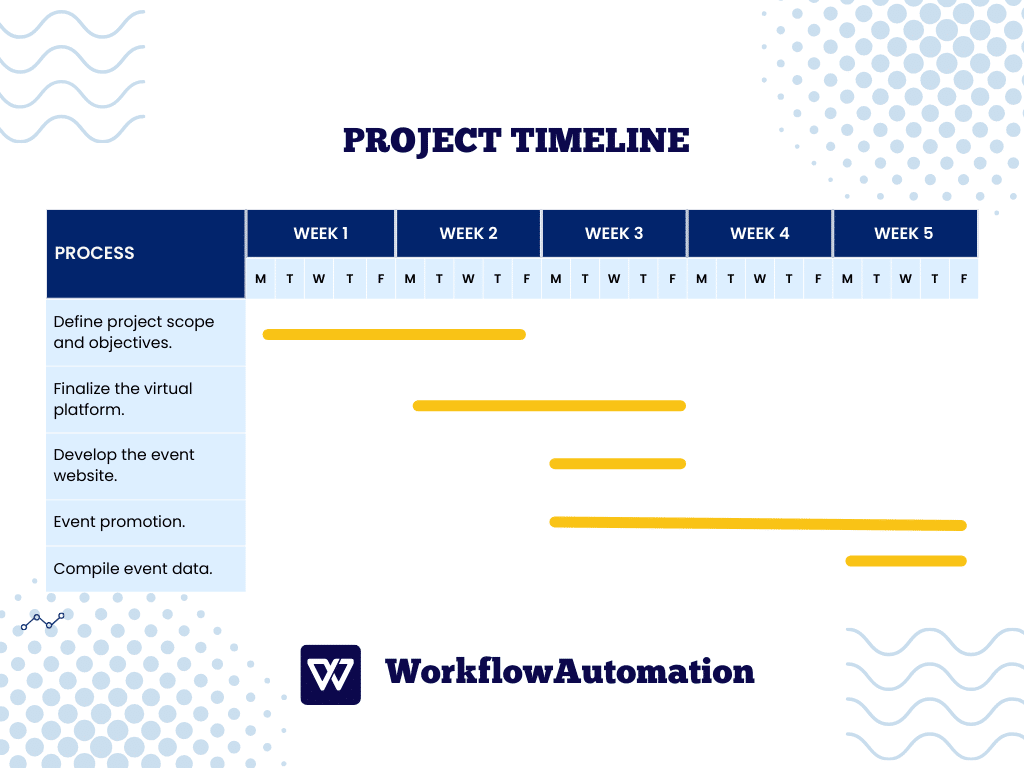Everything you need to know about tasks and their deadlines is captured in the project timeline.
Think of a project timeline as a clear roadmap outlining every team task and its due date. This visual guide becomes your compass, pointing you in the right direction to completing a project, even when faced with complex projects involving many tasks.
In the following guide, we’ll familiarize you with the project timeline’s meaning and importance and how to create it flawlessly in a few steps.
Let’s begin!
What is a Project Timeline?
A project timeline visually represents a project’s schedule and highlights all tasks and project milestones, as well as their respective deadlines.
As it brings clarity and fosters effective communication, it is crucial in planning and guiding the project from the initial to the final phase. That is why it’s essential for everyone involved—team members, project managers, stakeholders, and clients.
Moreover, having a visual representation of the project’s timeline that details the entire organization and duration of project tasks, phases, and the project itself allows you to allocate resources effectively and enhance overall productivity.
With this foundation established, let’s explore the concrete benefits of a well-constructed project timeline.
5 Benefits of a Project Timeline
There is no shortage of benefits a project timeline can bring you, but let’s take a look at the five most important ones:
- Efficient progress tracking: A project timeline allows teams to monitor progress efficiently, providing a clear overview of completed tasks and pending milestones.
- Deadline adherence: With defined deadlines for each task, project timelines ensure that teams stay on track and meet project completion dates.
- Enhanced communication: Project timelines foster better communication among team members, stakeholders, and clients, as everyone can visualize the project’s progress and upcoming milestones.
- Resource management: It helps optimize resource management by outlining task dependencies and ensuring resources are used efficiently throughout the project.
- Risk mitigation: Identifying potential bottlenecks or delays becomes more manageable with a project timeline, enabling teams to proactively address challenges and reduce project risks.
How to Create a Project Timeline
Now that we understand the significance and benefits of a project timeline, let’s delve into the process of creating one step by step.
Step 1: Define the Project Scope
First and foremost, it’s essential to clearly and precisely define the tasks and activities the project will involve, which we refer to as the project scope.
This crucial starting point requires thorough attention, as it embodies our comprehension of the project’s overarching goals. It answers questions about what we aim to achieve through the project and what lies beyond its boundaries.
So, to ensure a shared understanding among all involved parties, gathering key stakeholders and having them express their expectations, needs, and requirements is crucial. This collaborative effort will enable you to finalize the project scope, ensuring everyone is on the same page regarding the project’s objectives and activities to accomplish these goals.
With this approach, you will establish a clear project direction.
Step 2: Organize the Project Scope
Once we have identified and clearly defined the project scope, the next step is to structure it to ensure clarity and comprehensibility. This step is essential to prevent teams from becoming overwhelmed by the project’s many goals, activities, and tasks.
We should break down the established project scope into manageable segments or phases to achieve this. Each segment demands meticulous planning, ensuring a seamless organization of tasks, and establishing clear connections between the activities.
Step 3: Estimate Time Duration and Resources
In this step, you should consider various factors to determine the required time for completing tasks.
When estimating time duration, consider the type of tasks, meaning whether they are complex or straightforward, and the skills needed to carry them out. Realistically assess the expertise and experience of your team, as well as the availability of team members. Allocate tasks to individuals accordingly, ensuring optimal results.
Additionally, when estimating time, factor in potential risks and their impact on the timeline. You can also utilize historical data or an expert’s assistance to make well-informed estimates.
Step 4: Define Project Dependencies
Tasks within a project often rely on the completion of preceding tasks. Therefore, identifying and documenting these dependencies is vital to creating an accurate timeline.
Determine which tasks should be completed before others can start and establish the connections between them. This practice facilitates scheduling tasks in the correct sequence, preventing disruptions and bottlenecks.
You can also use various software programs to make these task connections transparent, aiding teams in understanding the interrelatedness of different activities and facilitating smoother communication among teams responsible for their execution.
Step 5: Determine the Milestones
As the project breaks down into manageable phases, each phase should represent significant progress markers. The completion of a stage should signify a milestone, encompassing substantial achievements or events for the project. Assign target dates to these milestones based on task estimates and dependencies.
Determining milestones is crucial because they provide a sense of accomplishment and serve as markers for tracking the project’s advancement. Therefore, when you achieve established milestones, celebrate them with your team to foster a sense of individual contribution and bring the goal closer.
Step 6: Build the Project Timeline
Now that you have all the necessary elements, it’s time to construct the project timeline. You can use various tools for this, like Venngage or SmartDraw. Start by plotting tasks, milestones, and their respective durations onto the timeline. You can use different colors or markers to distinguish between phases or tasks.
Ensure that task dependencies are accurately depicted, clearly indicating which tasks should be finished before others commence. This timeline serves as a visual roadmap, guiding the project toward completion.
Project Timeline Example
Since you’re now properly acquainted with every detail about project timelines, all that’s left is to see a good example of one:
Project: Virtual workshop on sustainable living
Objective: To host a virtual workshop to raise awareness about sustainable living practices and promote eco-friendly habits among participants.
Week 1:
- Define project scope and objectives
- Identify target audience and potential speakers
- Create a project plan and set a budget for the event
Week 2:
- Finalize the virtual platform
- Reach out to speakers and confirm availability
- Design event promotional materials
Week 3:
- Develop the event website with registration capabilities
- Start promoting the event through social media and email lists
- Set up an online registration form
Week 4:
- Continue event promotion and track registration numbers
- Coordinate with speakers on presentation materials
- Conduct a technical trial of the virtual event platform
Week 5:
- Conduct a virtual workshop on sustainable living
- Ensure smooth functioning of technical aspects during the event
- Collect feedback from attendees and send thank you emails
- Compile event data and input it into a post-event report
Conclusion
Having a project timeline from the beginning until the completion of a project is crucial for all participants and the project itself. It helps team members stay informed about their tasks and deadlines and, at the same time, allows the project manager to gain insights into resource allocation.
Together with the other stakeholders, the project manager obtains a complete and accurate understanding of the project’s progress and remaining tasks.
Creating a project timeline might present challenges, but following the steps we outlined in this article will streamline the process and ensure that all project participants are well-informed and on the same page.
Project Timeline FAQ
#1. How to create a project timeline?
To create a project timeline, you should define and organize the project scope, estimate time duration and resources, define project dependencies, determine the milestones, and build the project timeline.
#2. What should a project timeline include?
A project timeline should include tasks, their start and end dates, dependencies, milestones, and allocated resources.
#3. Are project timelines flexible?
Yes, project timelines are often adjustable to accommodate changes, delays, or unexpected circumstances. However, you should be careful when managing timelines and deliverables to avoid adverse impacts on the overall project.
#4. When should I create a project timeline?
During the project planning phase. The team should create a timeline once they have defined the scope, objectives, and tasks, and it is essential to have the timeline in place before the project execution begins.







